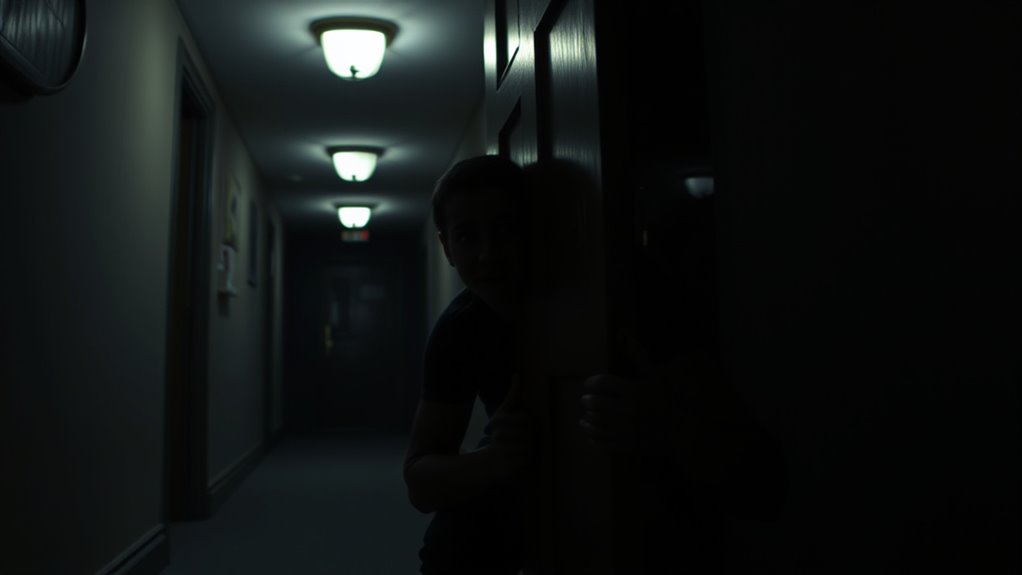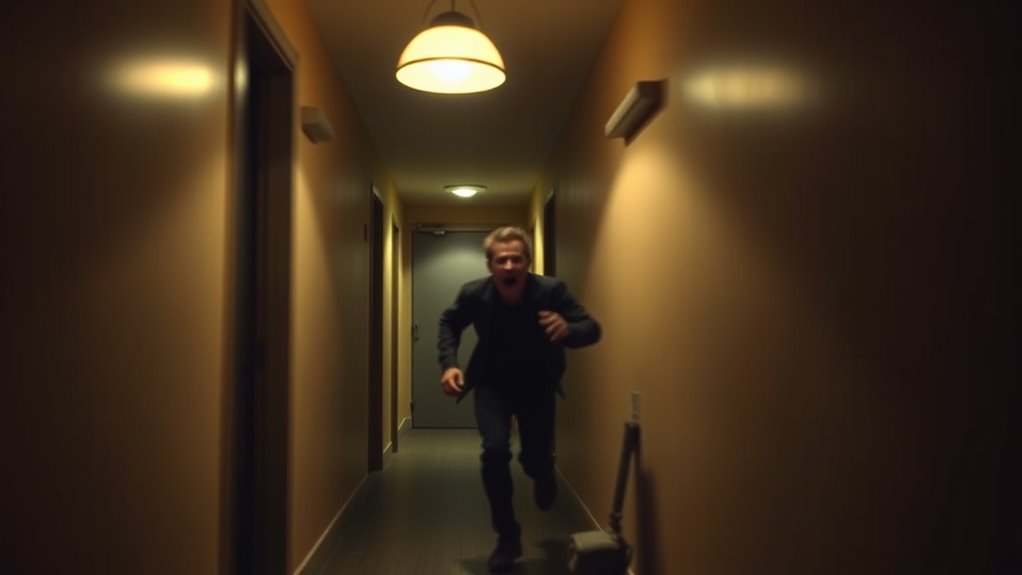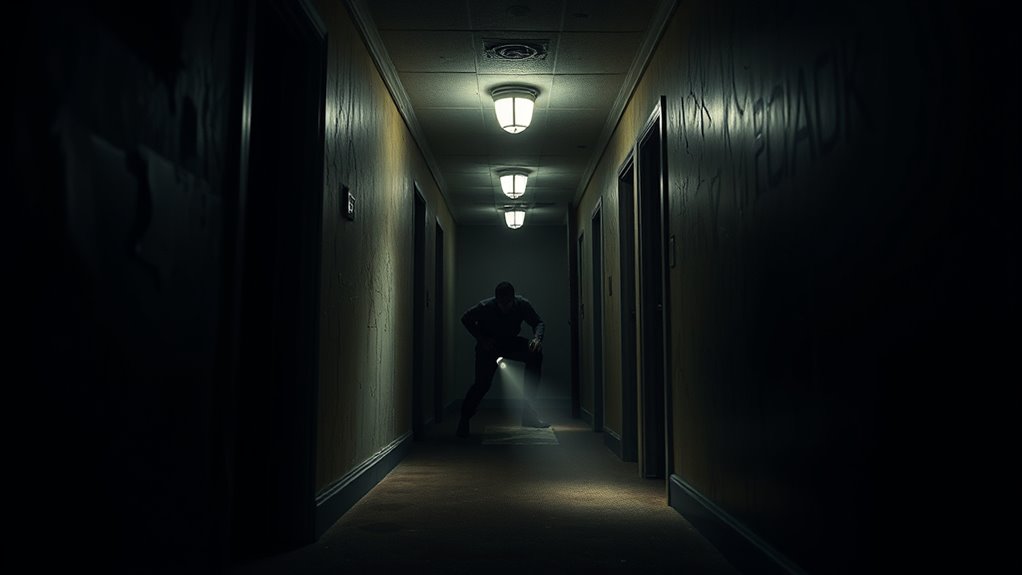To build a safe jump scare, focus on understanding how surprise triggers the brain’s fight-or-flight response and design your setup to maximize impact while respecting boundaries. Carefully choose content that fits your theme, timing it to build anticipation before the reveal. Use visual cues and sound effects strategically, and test everything with feedback to avoid overwhelming your audience. If you keep these principles in mind, you’ll craft effective, memorable scares that are both thrilling and safe.
Key Takeaways
- Design surprises that align with the story tone to evoke genuine fear without overwhelming or offending viewers.
- Use strategic lighting and sound cues to enhance suspense while maintaining clear pathways for safety.
- Incorporate visual contrasts and misdirection to create impactful scares that are not overly intense or repetitive.
- Test scare sequences with diverse audiences, gathering feedback to balance emotional impact and safety.
- Carefully plan timing and reveal to maximize surprise without rushing or delaying, ensuring a controlled, safe experience.
Understanding the Psychology of Surprise

Have you ever wondered why a sudden jump scare can make your heart race and your adrenaline spike? It’s all about the fear response triggered by surprise mechanisms in your brain. When something unexpected happens, your nervous system reacts quickly, activating the fight-or-flight response. This response floods your body with adrenaline, heightening your senses and preparing you to react. The surprise mechanism catches you off guard, causing an immediate emotional and physical reaction. Understanding this psychology helps you grasp why jump scares are so effective—they tap directly into your instinctive fear response. By knowing how your mind processes surprise, you can craft jump scares that are intense but safe, ensuring they evoke excitement without overwhelming or frightening your audience. Developing a methodical approach to timing and execution can further enhance the impact of your scares, making them more effective and memorable.
Setting Clear Intentions for Your Jump Scare

Before designing a jump scare, understanding your intended emotional impact is vital. Clear intentions help guide your choices and guarantee your scare aligns with your overall experience. Focus on what emotion you want to evoke—fear, surprise, or curiosity—and tailor your approach accordingly. This clarity enhances audience engagement and maintains thematic consistency. To deepen your planning, consider these factors:
Understanding your emotional goal ensures your jump scare resonates effectively within your story.
- Define the specific emotional response you aim for and how the scare supports it.
- Guarantee the scare fits seamlessly into your story’s tone and themes.
- Plan how the scare will build tension without overwhelming or alienating your audience.
- Recognize the importance of ethical considerations in creating scares that are impactful yet respectful. Setting clear intentions keeps your design purposeful and effective, making the experience memorable without crossing boundaries. It’s about creating a controlled, impactful moment that resonates with your viewers.
Choosing Appropriate Content and Themes

Selecting the right content and themes is essential to crafting an effective jump scare that resonates with your audience. Focus on horror motifs that align with your overall story, such as eerie atmospheres or unsettling visuals, to build tension naturally. When considering gore themes, be mindful of your target viewers; excessive gore can alienate or desensitize your audience if not used thoughtfully. Instead, use hints or suggestive imagery to evoke fear without overdoing it. The themes should support the emotional experience you want to create, whether it’s suspense, dread, or shock. Incorporating contrast ratio into your visual design can also heighten the impact of your scare, making key moments more striking. By choosing appropriate content, you guarantee that your jump scare feels authentic and impactful, enhancing the overall horror experience without crossing into discomfort or insensitivity.
Timing and Pacing to Maximize Impact

To create a memorable jump scare, you need to build anticipation right before the reveal. Managing the timing guarantees that the audience’s tension peaks exactly when you want the scare to hit. Perfect pacing keeps viewers on edge and maximizes the impact of each moment. Incorporating suspenseful ingredients can heighten viewers’ anticipation and make the scare even more effective.
Build Anticipation Effectively
Timing and pacing are crucial when building anticipation for a jump scare because they determine how effectively you grip your audience’s attention. To do this, carefully control when and how long you build tension. Use visual misdirection to mislead viewers, making the eventual reveal more startling. Incorporate moments of sensory overload, where sights and sounds become intense and overwhelming, heightening suspense. Active listening can help you gauge audience reactions and adjust your pacing accordingly.
- Use subtle hints or clues to keep viewers guessing without revealing too much
- Slow down pacing before the scare to build tension, then suddenly quicken it for shock
- Balance visual misdirection with strategic silence or distraction to maximize surprise
Mastering these techniques ensures your audience remains engaged and on edge, making your jump scare more impactful.
Manage Reveal Timing
Controlling when you reveal the scare is key to maximizing its impact. Focus on timing precision to guarantee the reveal hits at the perfect moment, heightening the audience’s surprise. A well-timed reveal leverages suspense buildup, allowing tension to simmer before snapping it with the scare. Don’t rush; instead, pace the buildup gradually, creating anticipation that makes the reveal more startling. Use silence, pacing, and visual cues to extend suspense, then strike unexpectedly. Timing missteps, like revealing too early or too late, can weaken the scare’s effect. By carefully managing the reveal timing, you keep viewers on edge, amplifying the emotional punch and ensuring your jump scare hits with maximum impact. Additionally, understanding cybersecurity vulnerabilities in digital content can help creators protect their work from tampering or unauthorized access, maintaining the integrity of your scare sequences.
Incorporating Visual and Audio Cues Effectively

Incorporating visual and audio cues effectively is essential for creating a jump scare that surprises without confusing your audience. You want these cues to enhance the story and heighten tension through precise visual storytelling and sound design. Sudden flashes of a shadow or quick camera cuts can build anticipation, while well-timed sound effects amplify the shock. To deepen the impact, consider:
- Using visual contrasts, like dark backgrounds with sudden bright highlights, to grab attention
- Syncing sound effects perfectly with visual cues to create a seamless experience
- Avoiding overuse of cues that could desensitize viewers or dilute the scare
- Incorporating sustainable techniques to ensure your scare remains effective over multiple viewings
Balancing these elements guarantees your jump scare hits hard, making it memorable without overwhelming or confusing your audience.
Ensuring Audience Comfort and Accessibility

Creating a jump scare that respects your audience’s comfort and accessibility is essential for a memorable and inclusive experience. To do this, incorporate distraction techniques that redirect attention away from potential distress points, reducing shock overload. Use clear cues to prepare viewers, allowing them to anticipate the scare without feeling overwhelmed. Engaging your audience through thoughtful pacing and inclusive design ensures everyone can participate comfortably. Remember, accessibility means considering visual, auditory, and cognitive needs—such as subtitles, alternative audio descriptions, or adjustable sound levels. Additionally, understanding the support hours of entertainment venues can help in planning your scare experience to avoid peak times and ensure assistance if needed. By prioritizing audience engagement with these strategies, you create an experience that is thrilling yet respectful, fostering enjoyment without discomfort. Ultimately, balancing surprise with consideration enhances the overall impact of your jump scare.
Testing and Gathering Feedback Safely

Before fully launching your jump scare, it’s crucial to test it and gather feedback in a way that prioritizes safety and comfort. Focus on audience engagement by observing reactions and listening to concerns. This helps you assess whether the scare maintains content originality without crossing boundaries. To deepen your understanding, consider these points:
- Conduct anonymous surveys to guarantee honest feedback about intensity and impact
- Use controlled environments to monitor reactions without overwhelming participants
- Incorporate diverse test groups to identify potential discomfort across different audiences
- Incorporating mindfulness techniques can help you gauge emotional responses and ensure the experience remains positive.
Using Lighting and Sound to Enhance Safety

You can improve safety by carefully placing lighting to guide guests and prevent accidents. Using sound cues can alert visitors to upcoming scares or hazards, keeping everyone aware of their surroundings. When combined thoughtfully, lighting and sound create an immersive experience that also prioritizes safety. Incorporating mindfulness techniques into your planning can help ensure that guests remain aware of their environment and respond appropriately to cues.
Strategic Lighting Placement
Have you ever considered how strategic lighting can make a jump scare both more effective and safer? Proper placement guides guests’ attention and minimizes accidents. Use ambient shadows to create depth, making the scene feel immersive without obscuring hazards. Position lights to highlight key areas, ensuring pathways stay visible and safe. Incorporate color contrast to draw focus to the scare element while maintaining visibility elsewhere. This contrast helps viewers instinctively react without confusion. Avoid uneven lighting that can cause tripping or disorientation. Consider the placement of lights to cast shadows intentionally, enhancing suspense while keeping walkways clear. Thoughtful lighting placement heightens the scare’s impact and ensures safety, balancing thrill with security. Additionally, integrating lighting control systems can help dynamically adjust illumination levels for optimal safety and effect.
Sound Cues for Safety
Effective sound cues can considerably enhance safety during a jump scare by guiding guests’ attention and alerting them to potential hazards. Carefully chosen sound effects serve as auditory signals that draw focus to specific areas or warn of upcoming surprises. By adjusting volume control appropriately, you guarantee sounds are noticeable without causing discomfort or disorientation. For example, subtle cues like a sudden increase in ambient noise can signal an approaching scare, while calming sounds can reassure guests afterward. Always test your sound effects at different volume levels to find the right balance, preventing sounds from being too loud or too soft. Incorporating sound cue timing ensures that cues are delivered precisely when needed, maximizing safety and engagement. Using sound cues thoughtfully helps maintain safety, keeping guests alert and engaged while avoiding unnecessary panic.
Balancing Shock Value With Emotional Impact

While shocking your audience can deliver a immediate jolt, it’s equally important to guarantee that the scare resonates emotionally. Relying solely on horror clichés or jump scare myths might produce quick reactions but can weaken the overall experience. To balance shock value with emotional impact, focus on building tension and atmosphere that connect with your audience’s feelings. Use genuine storytelling to create relatable characters and scenarios that evoke empathy. Incorporate moments of silence or slow buildup to heighten anticipation before the scare hits. This approach ensures the scare isn’t just superficial but leaves a lasting impression. Remember, the most memorable scares often stem from emotional engagement rather than mere shock, making your jumps feel meaningful instead of cheap tricks. Additionally, leveraging AI writing tools can help craft compelling narratives that deepen emotional resonance with your audience.
Ethical Considerations and Respecting Your Audience

Creating a jump scare that respects your audience involves more than just aiming for shock; it requires careful consideration of their emotional well-being. To foster genuine audience engagement, focus on content originality that surprises without causing harm. Avoid relying solely on cheap tricks or overly intense scares that might upset viewers. Instead, craft scenarios that evoke curiosity and anticipation, allowing your audience to feel involved rather than overwhelmed. Respecting your viewers means understanding their boundaries and designing scares that thrill without crossing ethical lines. Remember, a memorable scare balances excitement with responsibility, ensuring your audience feels entertained rather than distressed. Incorporating ethical considerations helps maintain a positive viewer experience and build trust. By prioritizing ethical considerations, you build trust and create a more impactful, memorable experience that respects the emotional limits of your audience.
Frequently Asked Questions
How Can I Prevent Long-Term Emotional Distress From a Jump Scare?
To prevent long-term emotional distress from a jump scare, you should focus on building emotional resilience. Practice deep breathing or grounding techniques to manage sudden shock. If you feel overwhelmed, seek psychological support to process the experience. Remember, understanding your boundaries and avoiding overly intense scares can help maintain your mental well-being. Prioritize self-care and be mindful of your emotional responses to ensure lasting resilience.
What Safety Measures Should I Implement During Live Scare Events?
During live scare events, prioritize guest safety by clearly marking escape routes and having staff ready to assist. Guarantee all equipment safety measures are in place, like secure wiring and stable props, to prevent accidents. Use sound and lighting cues responsibly to avoid overwhelming guests. Regularly inspect the setup and train staff on emergency procedures. By taking these steps, you create a thrilling experience without compromising safety.
How Do Cultural Differences Affect Audience Reactions to Scares?
Cultural differences profoundly influence how your audience reacts to scares, as cross-cultural perceptions shape their emotional sensitivity. You should research various cultural norms and taboos, tailoring your scares to respect these differences. By understanding diverse emotional sensitivities, you can create scares that are effective without offending. Adjusting your content accordingly ensures your event resonates positively across different cultural backgrounds, increasing engagement and avoiding unintended discomfort.
Can Jump Scares Be Effective Without Loud or Sudden Sounds?
Yes, jump scares can be effective without loud or sudden sounds. You can engage your audience through clever visual cues and suspense building, which keeps viewers on edge. By focusing on timing, atmosphere, and unexpected visuals, you create a tense environment that heightens audience engagement. This approach makes the scare more immersive and memorable, proving that sound isn’t always necessary for a successful jump scare.
How Should I Handle Emergency Situations During a Scare Setup?
When handling emergency situations during a scare setup, you should follow established emergency protocols and guarantee safety equipment is easily accessible. Quickly assess the situation, alert any participants, and shut down the scare immediately if needed. Keep calm, communicate clearly, and have a plan for safe evacuation. Regularly rehearse emergency procedures beforehand to ensure everyone knows their roles, reducing risks and maintaining safety throughout the event.
Conclusion
Just like Icarus dared to approach the sun, crafting a safe jump scare requires careful balance. By understanding your audience’s psychology, timing your cues, and respecting boundaries, you create an experience that surprises without harm. Remember, the true art lies in evoking genuine reactions, not flight or fright. When you harmonize safety with spectacle, you craft a moment as memorable as Orpheus’s song—powerful, enchanting, and above all, safe.









